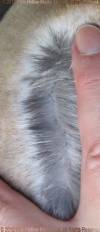Agouti Group (A-)
The agouti group of colors carries the original (wild) color pattern, where the body color comes from hairs that are banded. The tip color is determined by the B and D genes and is black in castors, chocolate in ambers, blue in opals, and lilac in lynxs. Next to it along the same hair shaft should be a red or orange color in the castors and ambers (the redder the better), and a lighter fawn color in the opals and lynxes, all allowing for a bluer hue in the blacks and a browner hue in the chocolates. Farther down the hair shaft is a blue color which should be slate in the castors and opals and much lighter in ambers and lynx. The base is a light dove grey or white. The guard hairs are typically the ones that are tipped. The surface belly color is tan, off-white, or white again, with the dilutes having the lighter colors. The undercolor should be the same as the undercolor of the body.
Full Color Concentration (C-)
| Agouti Patterns | This is the “natural” (wild) color pattern. | ||||||
|---|---|---|---|---|---|---|---|
| Color | A | B | C | D | E | En | |
| Castor | A- | B- | C- | D- | E- | enen | This is the wild color: black agouti |
| Amber | A- | bb | C- | D- | E- | enen | chocolate agouti |
| Opal | A- | B- | C- | dd | E- | enen | blue agouti |
| Lynx | A- | bb | C- | dd | E- | enen | lilac agouti |
Chinchilla (Cchd- )
The second Shading Gene can be cchd, cchl, ch, or c, but not C
The chinchilla gene prevents some of the yellow pigment from forming, leaving the animal looking much like a 'black & white' version of the full color. Since some yellow remains, the midband (and any other parts that would normally be red/yellow) will have a pearl color rather than being white.
In Rex, only the black version of Chinchilla is recognized.
| Chinchilla | |||||||
|---|---|---|---|---|---|---|---|
| Color | A | B | C | D | E | En | |
| Chinchilla | A- | B- | cchd- | D- | E- | enen | |
| Chocolate Chinchilla (Red Squirrel) | A- | bb | cchd- | D- | E- | enen | |
| Squirrel (Blue Chinchilla) | A- | B- | cchd- | dd | E- | enen | |
| Lilac Chinchilla | A- | bb | cchd- | dd | E- | enen | |
Sable or Shaded (cchl-)
The second Shading Gene can be cchl, ch, or c, but not C or cchd. The phenotype depends on the second allele because the shaded allele is not fully dominant over the ones below it.
| Sable Agouti | These are often hard to distinguish from chinchillas. | ||||||
|---|---|---|---|---|---|---|---|
| Color | A | B | C | D | E | En | |
| Sable Agouti | A- | B- | cchl- | D- | E- | enen | Looks like Chinchilla, but is often faulted for poor ring color. |
| Chocolate Sable Agouti | A- | bb | cchl- | D- | E- | enen | Looks like a chocolate chin, but undercolor will be same as tipping. Not a recognized Rex Color. |
| Blue Sable Agouti | A- | B- | cchl- | dd | E- | enen | Looks like a Squirrel (Blue Chin). Not a recognized Rex Color. |
| Lilac Sable Agouti | A- | bb | cchl- | dd | E- | enen | Looks like a lilac chin. Not a recognized Rex Color. |
Himalayan (ch)
None of these are recognized in Rex. Agouti Cals show the agouti shading which will be most obvious around their nostrils, inside their ears and under their tails.
| Agouti Himalayan | |||||||
|---|---|---|---|---|---|---|---|
| Color | A | B | C | D | E | En | |
| Himalayan | A- | B- | ch- | D- | E- | enen | Possibly showable as a Californian (Black Himalayan) Would likely be faulted for poor point color. |
| Chocolate Agouti Himalayan | A- | bb | ch- | D- | E- | enen | |
| Blue Agouti Himalayan | A- | B- | ch- | dd | E- | enen | |
| Lilac Agouti Himalayan | A- | bb | ch- | dd | E- | enen | |
Further Resources
Wild River Rabbitry has a lovely illustrated Shaded Mini Rex Guide.
Judith Graf, Color Basics 1991 (self-published booklet)
Glenna M.Huffmon, The Basics of Color Genetics in Rabbits (I have the 1995 third edition)




















